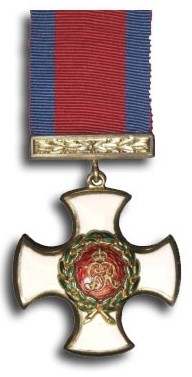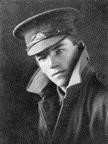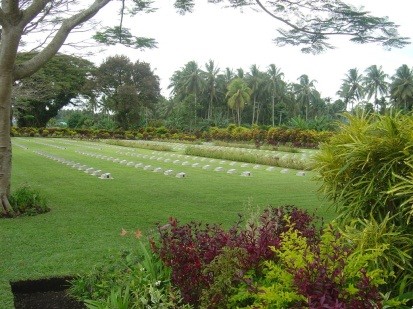Lieutenant Alan Fairlie Kyle, the son of Charles Gordon (George) George Kyle and Amelia Margaret Kyle (nee Thomas), was born in Queensland on 7th February 1898.
Alan Kyle, known as Bill, had served in World War 1 as a Sapper in the 4th Division Signal Company. Division Signals Companies belonged to the Royal Australian Engineers during WW1. Later, the Royal Australian Signals Corps was created. The Division Signals Company was tasked with providing communications from the Headquarters to those of subordinate formations. He enlisted on 7th February 1916 and was discharged for medical unfitness (heart condition) on 25th November 1917.
When the Japanese invaded Rabaul in World War 2, Alan Fairlie Kyle and Gregory Wade Benham were Assistant District Officer and Patrol Officer respectively at Namatanai on New Ireland some forty miles from Rabaul. After the Japanese seizure of Rabaul, they both moved down the east coast collecting planters and the odd missionary in the hope of reaching safety. Alan Kyle arranged for a boat to evacuate the group to safety. He was asked to remain and carry out duties as a coast watcher. Greg Benham although very ill refused to leave and insisted on remaining with Alan Kyle. They were both still civilians and had no obligation to remain in such a perilous position. Both were well aware that capture would result in torture and death. Four weeks after the fall of Rabaul, the men were joined by another ten refugees from Rabaul. Six weeks later Kyle and Benham managed to radio that they had the soldiers with them and had been joined by another party of men who escaped from Kavieng.
Kyle and Benham were notified that they had been appointed Lieutenant and Sub Lieutenant in the Royal Australian Navy Volunteer Reserve respectively on 2nd April 1942 and allocated to the Special Intelligence Service. Both men had wives back in Australia and arrangements were made for an allotment of pay to be paid to them. A boat was arranged to take the now twenty-three men to safety. Kyle and Benham again elected to stay and perform coast watching duties and to keep the natives at Namatanai loyal. The Japanese established civil administration in the area and subsequently Kyle and Benham were betrayed by natives and Chinese. An attempt by an American submarine to rescue them prior to their capture was unsuccessful. It was later learnt that Kyle and Benham were captured just eighteen hours before they were to be picked up. That the submarine had not been attacked at the rendezvous location shows that they had kept silent despite Japanese questioning. Prior to their capture, and having been appointed as officers in the Royal Australian Navy Volunteer Reserve, Alan Kyle had asked for service uniforms to be dropped as the Japanese were likely to treat them as spies if not wearing uniform.
After being held captive for four months, the Japanese decided to execute Alan Kyle and Greg Benham. A villager named Tulen witnessed the last moments of Alan Kyle and Greg Benham and several other captured coast-watchers. He reported that the men, blindfolded and with their hands tied behind them, were taken in two separate groups, about two months apart – by a Japanese barge from Kavieng wharf to Nago Island in the latter half of 1942. The barge later returned empty on both occasions. No doubt, they were all executed on the Nago Island by the Japanese Military Police (Kempei Tai). There can be little doubt that the prisoners would have been subject to merciless treatment at the hands of their captors before being savagely executed.
After the war and acting on reports received from natives, a party of Australians proceeded to Nago Island and found the bodies of Alan Kyle, Greg Benham and an elderly planter named Jack Talmadge buried together. The remains were collected and buried in a common grave at the Bita Paka War Cemetery at Rabaul.
Alan Kyle and Greg Benham were both awarded the Distinguished Service Cross for their bravery. Alan Kyle’s award was promulgated in the Commonwealth of Australia Gazette on 13th November 1945. The award was presented to his widowed wife by the Governor of New South Wales at Government House in Sydney on 26th February 1947.
Newspaper Item. Lieutenant Alan Fairlie (“Bill”) Kyle, D.S.C., R.A.N.V.R., formerly of the New Guinea Civil Administration, who has been presumed to have been killed at Kavieng, New Ireland, on September 1, 1942, was the only son of the late Mrs A.M. Kyle, Neutral Bay, Sydney, and formerly of Toowoomba. Lieutenant Kyle who was well known in Toowoomba and on the Downs, was an old boy of the Toowoomba Grammar School. He is survived by his wife, who is living in Sydney. Lieutenant Alan Fairlie Kyle was awarded a posthumous Distinguished Service Order for his work as a Coast Watcher.
The following newspaper story appeared in the West Australian on 26th November 1945:
NAVY AWARDS. D.S.C. to two officers.
Melbourne. November 25 – The award of the Distinguished Service Cross has been made to two Royal Australian Navy officers who were captured by the Japanese in New Ireland and are believed to have been killed by them. They are Lieutenant Alan Fairlie Kyle, R.A.N.V.R., of Neutral Bay, New South Wales and Sub Lieutenant Gregory Wade Benham, R.A.N.V.R., of Carlton, Sydney.
The citation says that they showed sustained fortitude in circumstances of great hazard in coast searching duties behind the Japanese lines in New Ireland, providing intelligence vital to the conduct of operations. Lieutenant Kyle, who was a patrol officer, and Sub Lieutenant Benham, both knew the country well in New Ireland and sent out very essential information before they were captured by the Japanese. Evidence which has come to hand since the reoccupation of New Ireland has established that they were killed by the Japanese after capture. They are presumed to have lost their lives on September 1, 1942, five months after they joined the Royal Australian Navy.
A detailed account of his capture and execution can be found in Patrick Lindsay’s book, “The Coast Watchers – Behind Enemy Lines”. William Heinemann Australia, 2010, and also Eric Feldt’s book, “The Coast Watchers”, Penguin Books, 1991.
Colin Simpson’s article, “Last Letters from New Ireland”, published in the Sydney Sunday Herald on 30th August 1953 gives an excellent account of both men’s lives including letters written by Alan Kyle to his wife Lilian.
Toowoomba Grammar School archive records show that he enrolled as a student on 1st January 1908 and that he left the School on 31st December 1911.

Distinguished Service Cross
External Links
Newspaper Article TROVE Sun 30 Aug 1953 the Sunday Herald




